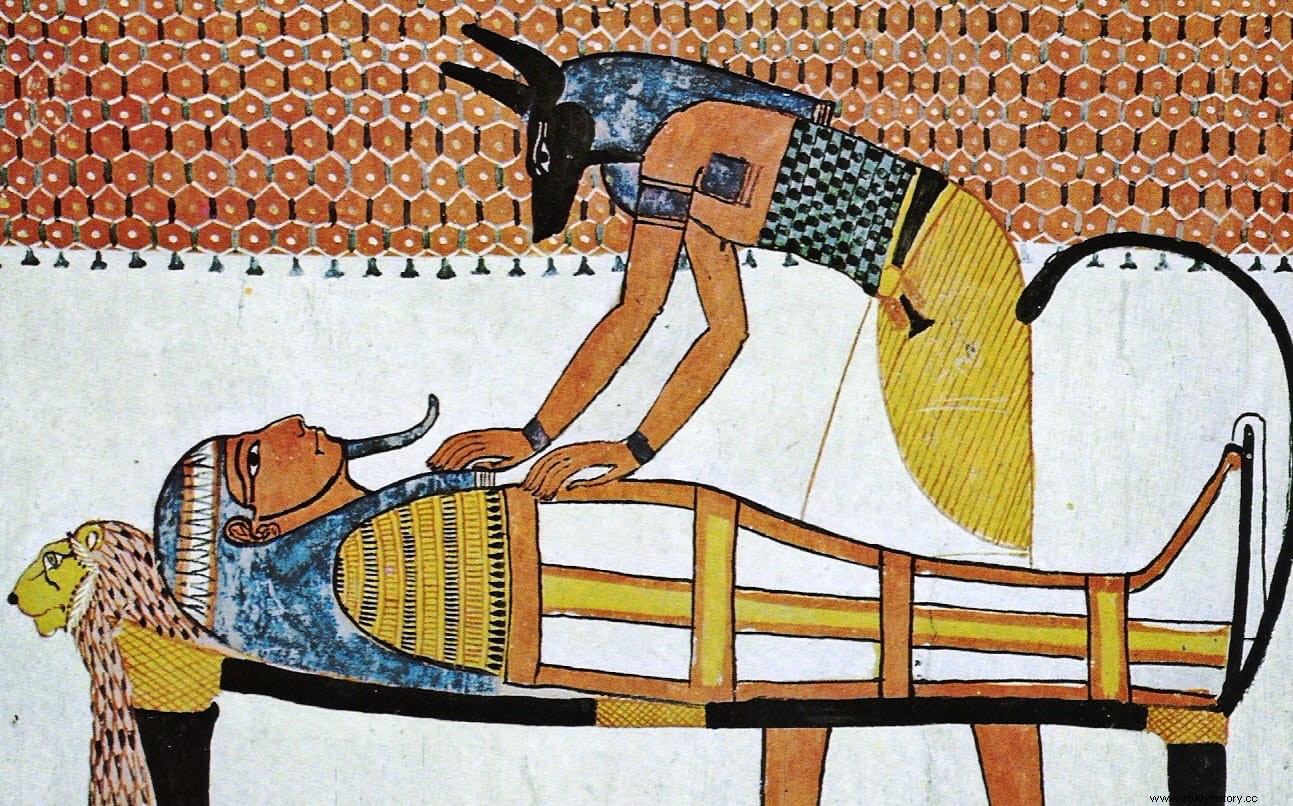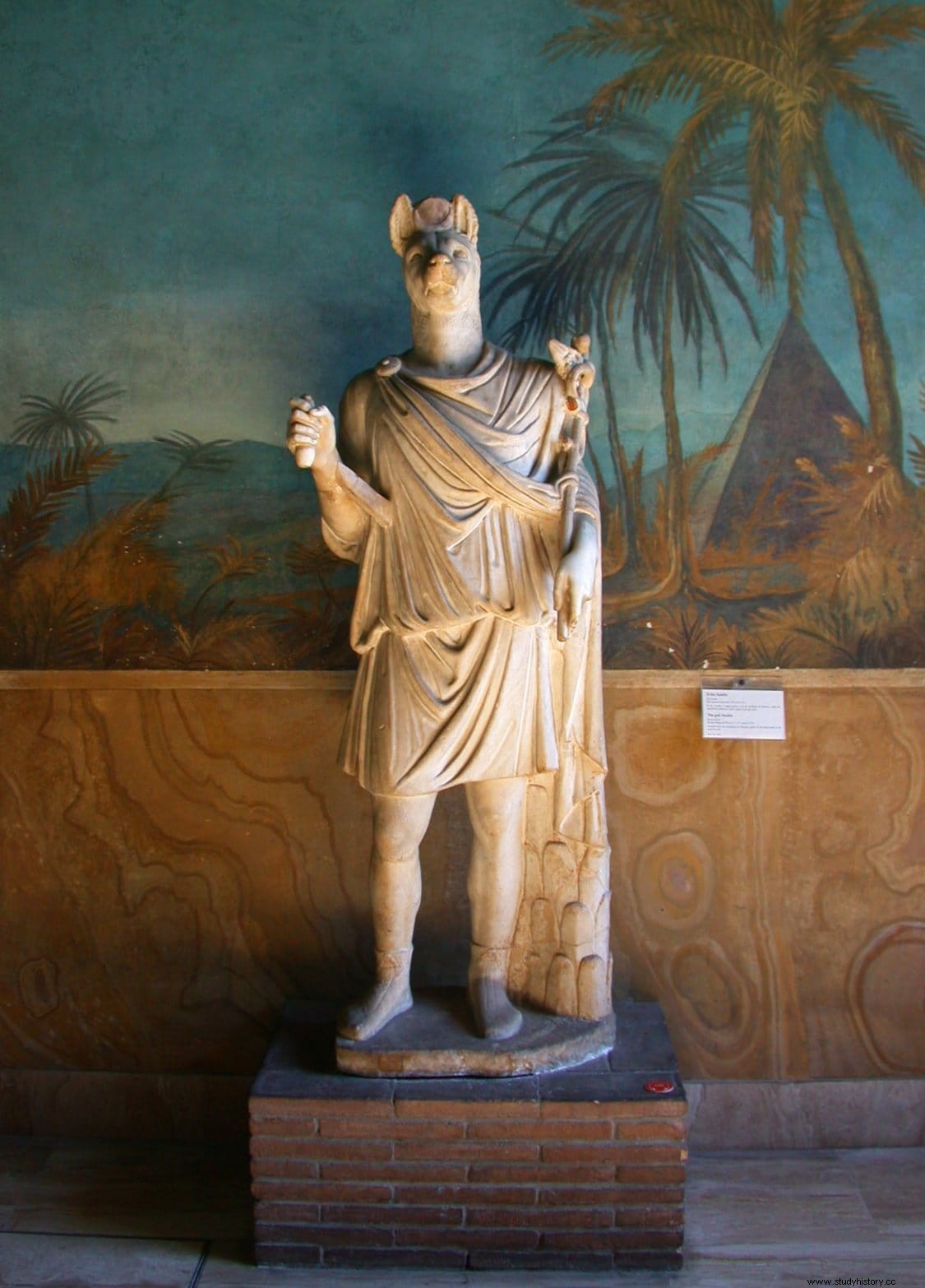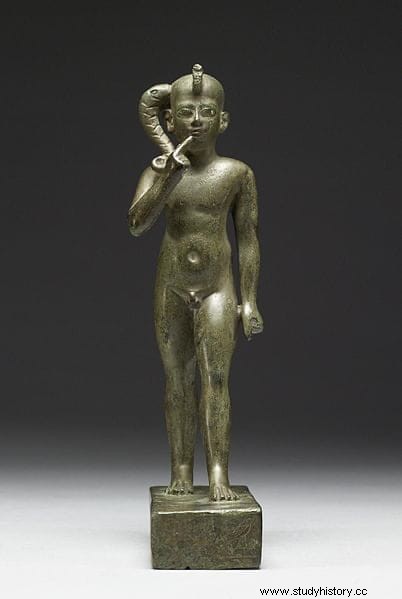Look at the image of that ancient divinity. Who would you say it represents? Anubis, the jackal-headed Egyptian god? Almost But no; the caduceus that he carries is the key to correctly identify him. It is a later hybrid that appeared in the Roman world that combined the characteristics of Anubis with those of the Greek Hermes, even in the name:Hermanubis.
The Romans had a recognized syncretic capacity and for this reason they adapted the classical Hellenic religion to their own by Latinizing the names, in a trend known as interpretatio graeca; Thus, Zeus became Jupiter, Hera became Juno, Poseidon Neptune, Athena Minerva, Artemis Diana, Aphrodite Venus, Ares Mars, etc. The messenger from Olympus, Hermes, would be assimilated to Mercury. But, above all, the Romans were practical and if people wanted to follow another faith, they were not a problem.
Christianity was the exception, due to its determination to subordinate imperial authority to that of God. However, the legionnaires used to worship the local divinities where they were assigned apart from their own, as evidenced by the epigraphic record, and Rome was filled with exotic religions that in the long run would have a more or less important incidence, in the case of Mithraism. One of those that was incorporated was the Egyptian, which came to have its own temples in Italian cities.

It is impossible to know how the figure of Hermanubis arose. The cynocephalians, that is, characters with the head of a canid, were not rare in ancient times and not only in Egypt, where apart from the theriomorph of the jackal there was a minor god called Am-heh (the Devourer of Millions , with a human body and the head of a hunting dog), but in many corners of the world:among the Massagetae, in India, in Africa... some medieval authors such as Marco Polo or Jean de Mandeville, among others, collected these legends in their works and even the Church would thus represent Saint Christopher.
The combination of similar gods was not uncommon either, and there is the case of Serapis, a mixture of Osiris and Apis. But in Greece it could be considered exceptional and some cases, like that of Hermaphrodite, confirm the rule. But Hermaphrodite, son of Aphrodite and Hermes with characteristics of both, would not be comparable due to the family relationship he had (although in reality it was the naiad Salmacis who gave him his ambivalent sexuality). More significant would be Hermes Trismegistus, in which the Greek Hermes and the Egyptian Toth merged due to the relationship of both with the esoteric, although the name was given by Christianity later, in the Middle Ages.

Plutarch, in his work Moralia , placed the origin of Hermanubis in the identification of its two divine components with the star Sirius, the brightest at night, also called Alpha Canis Maioris because it is in the constellation Can Major and to which Homer linked in The Iliad with the dog of the giant Orion. Interestingly, in other cultures it was also associated with this animal:the Chinese, for example, with the Celestial Wolf, but especially the Native Americans such as the Cherokees , who did it with a guard dog that formed a couple with Antares (another star), the Inuit with the Moon Dog, the black feet that called it Dog-Face, etc.
In Egyptian astronomy itself, Sirius was decisive in structuring the calendar of floods, these being fundamental in the agricultural cycle. It was also so in the so-called Sothic cycle (name that comes from Sotis, which is how the Greeks called the goddess Sopdet, personification of the star), a period of 1,460 years resulting from the accumulation of leftover days, since the calendar of that civilization always and invariably had 365 days. The truth is that all ancient peoples gave Sirius deserved importance.
The Sumerians, yes, subordinated it to Venus -represented by Inanna- and the Greeks considered its twinkling to be indicative of a torrid summer with drought (plus secondary effects such as the excitement of women, the weakening of men and the withering of plants). ), hence they called that stage Dog Days and offer him sacrifices asking him to send a breeze. For their part, the Romans, when the star set on April 25, also offered him a dog, in this case through the intermediary of the goddess Robigo, protector of the crops. Hellenic dog days, the warmest days of the year, were renamed canicula , a word that we still keep today.

The etymology of Sirius as a derivation of the name of Osiris proposed by some is not unanimously accepted. It is difficult to know because the term does not appear documented until the seventh century BC. in Hesiod's work Works and days; in fact, it is possible that the Hellenic Seirios came from elsewhere, imported in the Archaic Age. In any case, it is interesting because Osiris was the Egyptian god of resurrection, lord of the world of the dead who presided over their judgment, as well as being responsible for agriculture and fertility through the cyclical regeneration of the Nile.
And it turns out that Hermanubis was considered the revealer of the mysteries of the underworld, understanding as such not Hades but the deepest corner of our world; that is why he also revealed the secrets of sexuality. His task bore a certain resemblance to that of Anubis who, apart from embalming the corpses, was in charge of balancing the hearts of the deceased with the feather of Maat to determine their salvation or condemnation. Anubis was also the one who guided said deceased to the presence of Osiris, which served the Greeks to relate him to Hermes.
In this function, Hermes, Olympic herald along with Iris, had qualities such as cunning and deception. As the latter is based on moving from one thing to another, from one state to another, he also had the job of guarding the trips. And there was no trip more important than the last one, that's why he also acted as psychopomp, that is, guide of the dead towards the underworld; just like Anubis. But, in addition, he also sponsored eloquence which, combined with his previous occupation, made him a hermeneus, an interpreter who traveled with strangers and was able to understand the hidden meaning of things.

Consequently, the Romans took Anubis on one side, Hermes on the other, mixed and stirred them, and got a cocktail they called Hermanubis, a syncretic god that the priestly class chose as their representative for obvious hermeneutical reasons.
He had some popularity and appears in both epigraphic and literary sources; We have already seen that classical authors mentioned it in his writings:not only Plutarch (who was Greco-Roman for more inri ) but also Porphyry (a Neoplatonic philosopher who lived between the 3rd and 4th centuries AD and who was, of course, Greek), in his De imaginibus .
In art, Hermanubis is reproduced as an anthropomorphic figure with the head of a jackal or dog, sometimes surmounted by a sun disk and sometimes holding an anjada cross alluding to regeneration.
Now, the most significant accessory, head apart, is that it carries the sacred caduceus of Hermes:an olive rod with two coiled serpents that rise towards a pair of wings and that served to open or close the eyes of mortals. A gift given to him by Apollo as a symbol of trade, of which he was the protector and which serves to distinguish him from Anubis.

Although there are representations of Hermanubis in armor, he is usually shown wearing priestly clothing, a symbol of science, mystery and intellect. After all, over time the Romans gave him a third twinning assimilating him to Harpocrates, another Egyptian god (Harpajered, in original) who was the version of Horus that was given in Alexandria.
He is often called Horus the Child because he is depicted with a finger to his lips; however, it is an erroneous interpretation and Plutarch explains that iconography as “symbol of discretion and silence” because he is "he who rectifies and corrects the thoughtless, imperfect and partial opinions so widespread among men regarding the gods".
This quality meant that centuries later, during the Renaissance, Anubis-Hermes-Harmanubis-Harpocrates ended up being adopted as a symbolic representation by philosophers and alchemists (at that time they were activities that were not only compatible but complementary).
